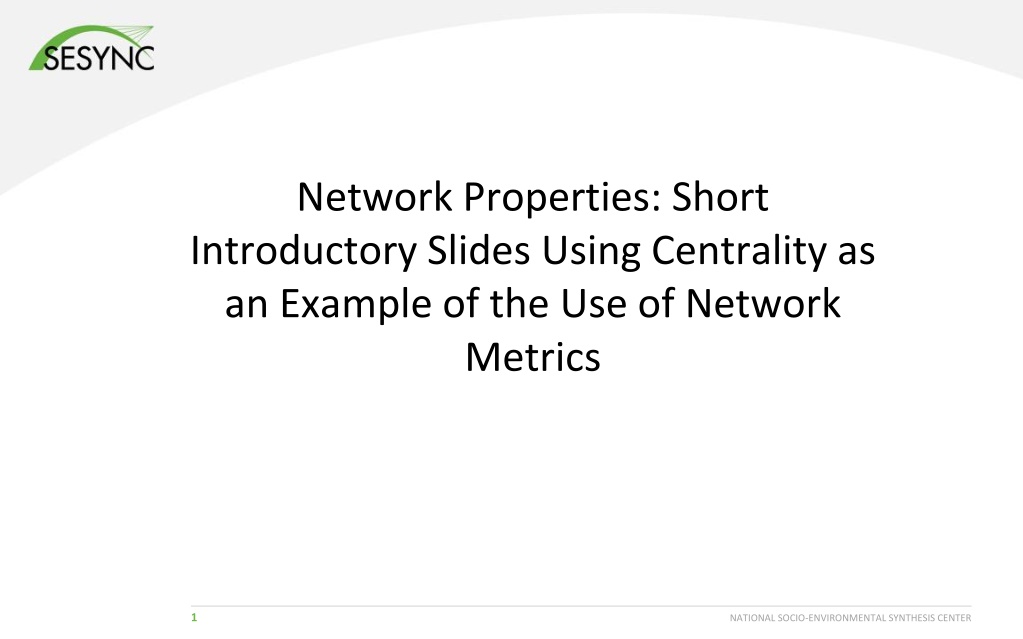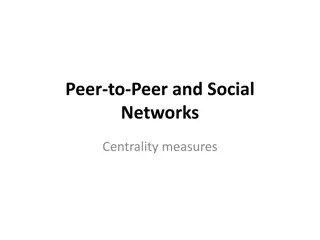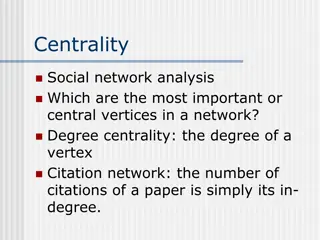Understanding Network Metrics Through Centrality Analysis
This presentation introduces network metrics as tools to describe network characteristics and answer important questions. Using centrality metrics as an example, participants learn how to identify the most important nodes in a network based on different criteria such as degree centrality and closeness centrality. Through visual examples and thoughtful questions, the audience delves into exploring the significance of different nodes in a network structure.
Download Presentation

Please find below an Image/Link to download the presentation.
The content on the website is provided AS IS for your information and personal use only. It may not be sold, licensed, or shared on other websites without obtaining consent from the author. Download presentation by click this link. If you encounter any issues during the download, it is possible that the publisher has removed the file from their server.
E N D
Presentation Transcript
Network Properties: Short Introductory Slides Using Centrality as an Example of the Use of Network Metrics 1 NATIONAL SOCIO-ENVIRONMENTAL SYNTHESIS CENTER
Network properties metrics to describe characteristics of networks useful for answering questions (e.g., is there are species in a network that many other species depend on?) some are simple to calculate but many require matrix algebra most common ones belong to a group of centrality metrics 2 NATIONAL SOCIO-ENVIRONMENTAL SYNTHESIS CENTER
Question to participants: How would you determine the most important species in this network? 3 NATIONAL SOCIO-ENVIRONMENTAL SYNTHESIS CENTER
Question to participants: How would you determine the most important species in this network? Depends on how you define importance: 1. species that has the most relationships? 2. species that can influence the most other species? 3. species that plays the biggest role in connecting other species? 4 NATIONAL SOCIO-ENVIRONMENTAL SYNTHESIS CENTER
1. An important node may be one with the most relationships, i.e., the most links ( degrees ) Degree centrality a node s degree (# of links regardless of direction). the simplest measure of centrality In the below network, which node is most central ? 5 NATIONAL SOCIO-ENVIRONMENTAL SYNTHESIS CENTER
1. An important node may be one with the most relationships, i.e., the most links ( degrees ) Degree centrality a node s degree (# of links regardless of direction). the simplest measure of centrality Two nodes have the same highest degree centrality! 6 NATIONAL SOCIO-ENVIRONMENTAL SYNTHESIS CENTER
2. An important node may be the one with the most access to others (shortest paths to others) closeness centrality a node with shortest mean distance between it and other nodes In the below network, which node has the lowest closeness centrality score? A E B F D D C H G 7 NATIONAL SOCIO-ENVIRONMENTAL SYNTHESIS CENTER
2. An important node may be the one with the most access to others (shortest paths to others) closeness centrality a node with shortest mean distance between it and other nodes In the below network, which node has the lowest closeness centrality score? To determine closeness, calculate the following for each node assuming bidirectional (reciprocal) paths; then compare the means; smallest = closest A Node A B C E F G H Shortest path for from D 3 (D-C-B-A) 2 1 1 2 2 1 E B F D D D C H G Average = (3+2+1+1+2+2+1) = 12/7 = 1.7 8 NATIONAL SOCIO-ENVIRONMENTAL SYNTHESIS CENTER
A B C D E F G H A 1 2 3 4 5 5 4 B 1 1 2 3 4 4 4 C 2 1 1 2 3 3 2 D 3 2 1 1 2 2 1 E 4 3 2 1 1 1 1 F 5 4 3 2 1 1 2 G 5 4 3 2 1 1 1 H 4 4 2 1 1 2 1 SUM 24 19 14 12 13 18 17 15 mean 3.4 2.7 2 1.7 2 3 2.4 2.14 9 NATIONAL SOCIO-ENVIRONMENTAL SYNTHESIS CENTER
3. An important node may be one providing the most bridges to other nodes betweeness centrality the node that lies on the shortest path between two other nodes in the network the most times (i.e., removing it severs parts of the network) In the below network, which node is the most important bridge? x 10 NATIONAL SOCIO-ENVIRONMENTAL SYNTHESIS CENTER
3. An important node may be one providing the most bridges to other nodes betweeness centrality the node that lies on the shortest path between two other nodes in the network the most times (i.e., removing it severs parts of the network) In the below network, which node is the most important bridge? x if dark node is lost 11 NATIONAL SOCIO-ENVIRONMENTAL SYNTHESIS CENTER
We can also ask questions about entire networks Network connectance = # links/nodes2 i.e., the # of possible connections that are realized Out of all the connections possible, how many are actually present? 12 NATIONAL SOCIO-ENVIRONMENTAL SYNTHESIS CENTER
We can also ask questions about entire networks Network connectance = # links/nodes2 i.e., the # of possible connections that are realized Out of all the connections possible, how many are actually present? 9 species/people 4 connections Connectance = 4/81 = 0.49 13 NATIONAL SOCIO-ENVIRONMENTAL SYNTHESIS CENTER
Problem with connectance calculation: can t use it to compare networks with different #s of nodes because the number of interactions does not scale with the square of the # of nodes so we use Network average degree = # links/# nodes i.e., the average node degree, where node degree = its # of links A B C 14 NATIONAL SOCIO-ENVIRONMENTAL SYNTHESIS CENTER
Problem with connectance calculation: can t use it to compare networks with different #s of nodes because the number of interactions does not scale with the square of the # of nodes so we use Network average degree = # links/# nodes i.e., the average node degree, where node degree = its # of links Node A degree = 3; Node B degree = 1; Node C degree = 2 Network Average Degree = 4/9 = 0.44 A B C 15 NATIONAL SOCIO-ENVIRONMENTAL SYNTHESIS CENTER























